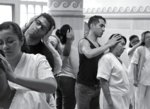

In 1988, Stuart Pimsler created “Swimming to Cecile,” a performance work dedicated to his mother who died in a car accident when he was 15. “Cecile,” a lamentation inspired by his own loss, was toured throughout the U.S. This work served as the initial connection from Pimsler to the community of caregivers who experience losses in their own workplace each day.
He founded Stuart Pimsler Dance & Theater (SPDT) in 1979 in NYC, and has been based at 528 Hennepin Ave. since 2001. For over four decades Pimsler’s company has toured globally, with international presentations in Canada, Mexico, Bermuda, western Europe, China, Russia, and Israel, as well as engagements in 37 states.
SPDT’s program “Caring for the Caregiver” was started in 1992 following a performance of “Swimming to Cecile.” A teary-eyed pediatric oncologist knocked on their dressing room door and asked if they would be willing to work with his colleagues. Since that moment, SPDT has worked with thousands of caregivers throughout the world.
“Once introduced to the world of caregivers, I became deeply moved by the courage, compassion, and strength of these individuals who work daily helping others,” Pimsler said. “Their resilience in coping with loss, particularly in such areas as hospice and cancer, proved to be inspiring for me.”
SPDT also works with many colleges and universities. According to Pimsler, in traditional medical school training, the relational aspect of patient and doctor is often seen as secondary to the scientific aspects of information gathering. SPDT’s work leans into the empathic capacity of caregivers, focusing on methods to enhance communication between caregiver and patient.
“Our work integrating movement, literary, visual, vocal, and theatrical techniques invite caregivers to consider and remember their original impulses for becoming healers,” Pimsler said. “It holds a mirror to their everyday demeanors and emotional life in relating to their patients while offering feedback about caregivers’ empathic capacities.”
Beyond self-expression, a growing body of research shows how movement enhances cardiovascular health and brain functioning. According to Harvard Medical School, a study was done showing that dancing was linked to a lower risk of cardiovascular death. The most direct and immediate outcome of SPDT’s work is a reduction of stress and a deepening of connections amongst caregivers and colleagues. They also always include suggestions and lively discussions focusing on the importance of self-care.
An issue brief released by the U.S. Department of Health and Human Services this past May noted, “The COVID-19 pandemic has put extreme stress on the health care workforce in the United States, leading to workforce shortages as well as increased health care worker burnout, exhaustion, and trauma. These pandemic-related challenges have taken place in a context of significant preexisting workforce shortages and maldistribution, as well as in a workforce where burnout, stress, and mental health problems (including an ongoing risk of post-traumatic stress disorder) were already significant problems.”
Pimsler mentioned that during the pandemic, an increase in patient demand, equipment shortages, and yet-to-be-discovered treatments and vaccines were an unprecedented reality for even the most tenured caregivers. He feels that with infections trending upward globally from the new Omicron variant, the effects from the ongoing COVID-19 pandemic are continuing to weigh heavy on caregivers and frontline workers.
“In addition to these more ‘traditional,’ expected impacts, caregivers found themselves taking care of each other,” Pimsler said. “We found ourselves addressing extreme situations where caregivers spoke about substance abuse and attempted suicides by colleagues who were trying to cope with the pandemic’s human devastation.”
Pimsler’s new book, “The Choreography of Care,” aims to address more than three decades of working in the field of arts and medicine. While providing a memoirish introduction to Pimsler’s unlikely trajectory for entering the field of arts in health, the book also offers insights and guides for the revelatory and healing powers the arts bring to medicine – not only for patients but for those who treat them. It can be found at www.choreogrpahyofcare.com.
His book suggests ways that both the public and caregivers can enhance their communicative rapport while re-considering their power dynamic. Pimsler said others can contribute to this issue by becoming better advocates for their own health through enhanced, healthful activities and better nutrition.
For individuals interested in seeing video examples of their work with caregivers, other community-engaged work or for more information regarding the Caring for Caregivers Program, browse: www.stuartpimsler.com.
Comments
No comments on this item Please log in to comment by clicking here